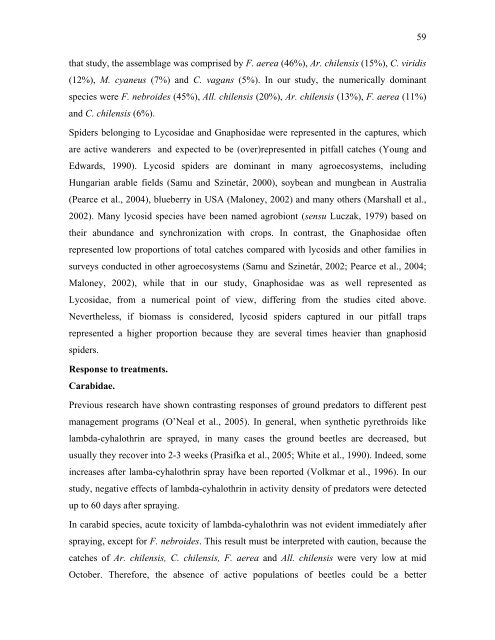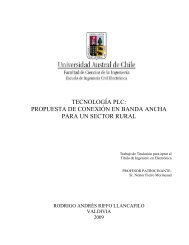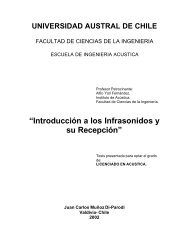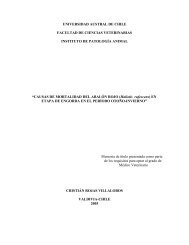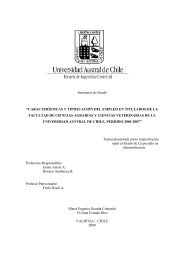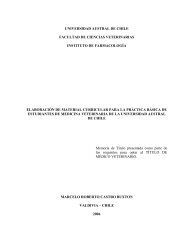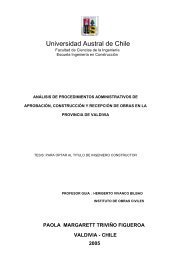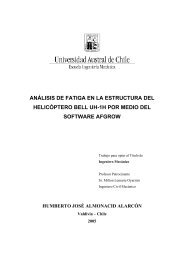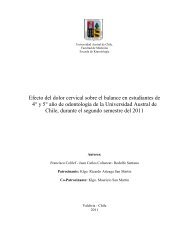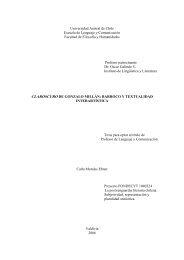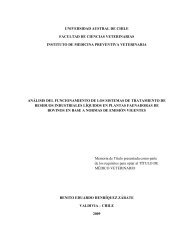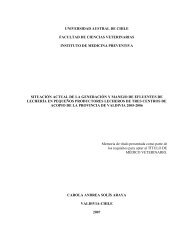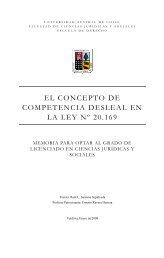Diversidad y control biológico de insectos - CyberTesis UACh ...
Diversidad y control biológico de insectos - CyberTesis UACh ...
Diversidad y control biológico de insectos - CyberTesis UACh ...
Create successful ePaper yourself
Turn your PDF publications into a flip-book with our unique Google optimized e-Paper software.
that study, the assemblage was comprised by F. aerea (46%), Ar. chilensis (15%), C. viridis<br />
(12%), M. cyaneus (7%) and C. vagans (5%). In our study, the numerically dominant<br />
species were F. nebroi<strong>de</strong>s (45%), All. chilensis (20%), Ar. chilensis (13%), F. aerea (11%)<br />
and C. chilensis (6%).<br />
Spi<strong>de</strong>rs belonging to Lycosidae and Gnaphosidae were represented in the captures, which<br />
are active wan<strong>de</strong>rers and expected to be (over)represented in pitfall catches (Young and<br />
Edwards, 1990). Lycosid spi<strong>de</strong>rs are dominant in many agroecosystems, including<br />
Hungarian arable fields (Samu and Szinetár, 2000), soybean and mungbean in Australia<br />
(Pearce et al., 2004), blueberry in USA (Maloney, 2002) and many others (Marshall et al.,<br />
2002). Many lycosid species have been named agrobiont (sensu Luczak, 1979) based on<br />
their abundance and synchronization with crops. In contrast, the Gnaphosidae often<br />
represented low proportions of total catches compared with lycosids and other families in<br />
surveys conducted in other agroecosystems (Samu and Szinetár, 2002; Pearce et al., 2004;<br />
Maloney, 2002), while that in our study, Gnaphosidae was as well represented as<br />
Lycosidae, from a numerical point of view, differing from the studies cited above.<br />
Nevertheless, if biomass is consi<strong>de</strong>red, lycosid spi<strong>de</strong>rs captured in our pitfall traps<br />
represented a higher proportion because they are several times heavier than gnaphosid<br />
spi<strong>de</strong>rs.<br />
Response to treatments.<br />
Carabidae.<br />
Previous research have shown contrasting responses of ground predators to different pest<br />
management programs (O’Neal et al., 2005). In general, when synthetic pyrethroids like<br />
lambda-cyhalothrin are sprayed, in many cases the ground beetles are <strong>de</strong>creased, but<br />
usually they recover into 2-3 weeks (Prasifka et al., 2005; White et al., 1990). In<strong>de</strong>ed, some<br />
increases after lamba-cyhalothrin spray have been reported (Volkmar et al., 1996). In our<br />
study, negative effects of lambda-cyhalothrin in activity <strong>de</strong>nsity of predators were <strong>de</strong>tected<br />
up to 60 days after spraying.<br />
In carabid species, acute toxicity of lambda-cyhalothrin was not evi<strong>de</strong>nt immediately after<br />
spraying, except for F. nebroi<strong>de</strong>s. This result must be interpreted with caution, because the<br />
catches of Ar. chilensis, C. chilensis, F. aerea and All. chilensis were very low at mid<br />
October. Therefore, the absence of active populations of beetles could be a better<br />
59


